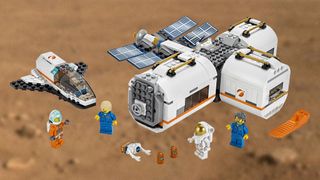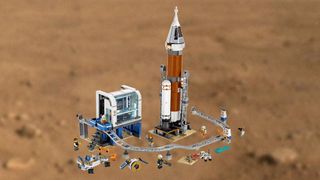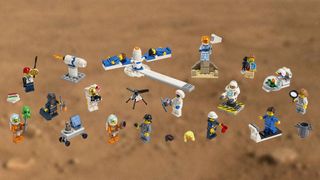New Lego Space Sets Take Kids to Mars, Brick by Brick

As NASA pushes to land humans on the moon and Mars in the coming years, the Lego Group has seven new space-themed building sets inspired the agency's Red Planet plans.
These sets will be released on Saturday (June 1) elsewhere in the world and on June 23 in North America, and are geared to children who are at least 5 years old.
(Separately, Lego has unveiled another set to commemorate the 50th anniversary of the first human moon landing on July 20, 1969.)
Related: Lego's Epic Apollo 11 Lunar Lander Set in Photos!
Here's a list of the seven Mars-inspired space sets that Lego has to offer:
Satellite Service Mission / 84 pieces, $9.99

This mission features a toy space shuttle with a cockpit — the perfect spot to place your minifigures. It also includes a satellite with solar panels that open up, to power the spacecraft. You can store the satellite in the shuttle during launch to space. Also included is a spacesuit (complete with gold visor), an astronaut minifigure and a wrench so that the astronaut can do repairs in orbit.
Rover Testing Drive / 202 pieces, $29.99

Astronauts on the Red Planet will depend on rovers to do geology and to travel long distances. Included with this rover is a grappling arm (to pick up those important samples), all-terrain wheels and a solar- panel generator to harvest power from the sun. Two astronaut minifigures take the ultimate road trip, equipped with geodes (a special rock formation hiding crystals inside), a laptop, a video camera, a remote control, a rock drill and a helmet with a visor.
Get the Space.com Newsletter
Breaking space news, the latest updates on rocket launches, skywatching events and more!
Mars Research Shuttle / 273 pieces, $39.99

If you always wanted to fly on Mars, this set will let you soar to new heights. This combination rover, space shuttle and drone set allows young builders to explore the Red Planet by land and by air.
Two astronaut minifigures have a spot to sit inside the space shuttle, which has room inside to store the drone. The rover includes a grappling arm, a laser and tilting solar panels. Then there are two aircraft: a storage drone with a compartment that opens and a helidrone with a scanner and helicopter-like spinning rotor blade. Numerous astronaut accessories — and a Mars scenery piece — are also available.
Lunar Space Station / 412 pieces, $59.99

Get ready for moon missions with this modular space station. There are three modules that you can move around in whatever configuration your astronauts need. The station includes an airlock, a kitchen, a living module where astronauts can sleep and train, and a lab module for scientific experiments. Also included in the kit is a detachable shuttle with a cockpit and a storage space, four minifigures, a robot and several astronaut accessories.
Deep Space Rocket and Launch Control / 837 pieces, $99.99

Get ready to launch to Mars! This rocket has all the parts needed for an amazing mission to the Red Planet. You can set the rocket atop a launchpad, which is easily connectable to a separate launch control center using a monorail. The launch control facility includes a detachable window section, and the ability to fold it out or set a countdown. This set comes with many accessories, including a robot, a space telescope, astronaut minifigures, ground personnel, and a tile with a secret symbol.
Rocket Assembly and Transport / 1,055 pieces, $149.99

This comprehensive set shows many of the elements needed to make a Mars launch work. The launch rocket sits atop a special crawler to bring it to the launch pad. A launch control center lets ground personnel stay in touch with the astronauts as they count down to liftoff. Some of the many other elements include a rover transport truck, a rover (including an arm and a drill), and several minifigures to crew the launch and support the mission on the ground.
People Pack — Space Research and Development / 209 pieces, $39.99

Space is a group effort, and this set shows some of the many jobs necessary to explore space and support astronauts. Minifigures can operate the equipment, which includes items such as a g-force training machine, a treadmill or a robot stand. Some of the many jobs portrayed include a personal trainer, a drone engineer, a rocket engineer, a robot and (perhaps in nod to the 2015 blockbuster "The Martian") a botanist.
- Lego Fan Vote Could Launch International Space Station As Toy Set
- Lego Fans Celebrate Release of Women of NASA Set
- How to Build Your Own LEGO Mars Rover Curiosity
Follow Elizabeth Howell on Twitter @howellspace. Follow us on Twitter @Spacedotcom and on Facebook.
Join our Space Forums to keep talking space on the latest missions, night sky and more! And if you have a news tip, correction or comment, let us know at: community@space.com.

Elizabeth Howell (she/her), Ph.D., is a staff writer in the spaceflight channel since 2022 covering diversity, education and gaming as well. She was contributing writer for Space.com for 10 years before joining full-time. Elizabeth's reporting includes multiple exclusives with the White House and Office of the Vice-President of the United States, an exclusive conversation with aspiring space tourist (and NSYNC bassist) Lance Bass, speaking several times with the International Space Station, witnessing five human spaceflight launches on two continents, flying parabolic, working inside a spacesuit, and participating in a simulated Mars mission. Her latest book, "Why Am I Taller?", is co-written with astronaut Dave Williams. Elizabeth holds a Ph.D. and M.Sc. in Space Studies from the University of North Dakota, a Bachelor of Journalism from Canada's Carleton University and a Bachelor of History from Canada's Athabasca University. Elizabeth is also a post-secondary instructor in communications and science at several institutions since 2015; her experience includes developing and teaching an astronomy course at Canada's Algonquin College (with Indigenous content as well) to more than 1,000 students since 2020. Elizabeth first got interested in space after watching the movie Apollo 13 in 1996, and still wants to be an astronaut someday. Mastodon: https://qoto.org/@howellspace
